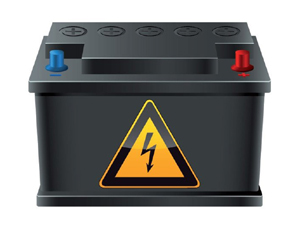



Date:09/03/17
 Researchers at The City College of New York-based CUNY Energy Institute announce the development of a novel low cost, rechargeable, high energy density battery that makes the widespread use of solar and wind power possible in the future. It is based on manganese dioxide (MnO2), an abundant, safe and non-toxic material.
Researchers at The City College of New York-based CUNY Energy Institute announce the development of a novel low cost, rechargeable, high energy density battery that makes the widespread use of solar and wind power possible in the future. It is based on manganese dioxide (MnO2), an abundant, safe and non-toxic material.
In a paper in the journal “Nature Communications,” the scientists report that the uniqueness of the battery is that it is able to achieve both high cycle life and high areal capacity. Achieving high areal capacity is critical for packing a lot of battery electrodes together into a battery case. In essence a high areal capacity is required to build a real, practical battery, as opposed to a small toy battery.
Past researchers have achieved either high cycle life or high areal capacity, but never both together, the team notes.
The innovation that makes this possible is intercalating copper (Cu) into bismuth-modified δ-MnO2, which is called birnessite. The latter was discovered by Ford Motor Company in the 1980s, but it was never known how to use it at high areal capacity. This was later discovered at the CUNY Energy Institute by a team led by Sanjoy Banerjee, Distinguished Professor and director of the Institute.
The battery is intended for use at the scale of the power grid. This would make widespread use of solar and wind power possible.
The research was funded by an Advanced Research Projects Agency-Energy (ARPA-E) grant from the Department of Energy.
CCNY research associate Gautam Yadav is the article’s lead author and principal inventor. Joshua Gallaway, Damon Turney, Michael Nyce, Jinchao Huang and Xia Wei were the other researchers.
CCNY-based team develops sustainable, high energy density battery
 Researchers at The City College of New York-based CUNY Energy Institute announce the development of a novel low cost, rechargeable, high energy density battery that makes the widespread use of solar and wind power possible in the future. It is based on manganese dioxide (MnO2), an abundant, safe and non-toxic material.
Researchers at The City College of New York-based CUNY Energy Institute announce the development of a novel low cost, rechargeable, high energy density battery that makes the widespread use of solar and wind power possible in the future. It is based on manganese dioxide (MnO2), an abundant, safe and non-toxic material.In a paper in the journal “Nature Communications,” the scientists report that the uniqueness of the battery is that it is able to achieve both high cycle life and high areal capacity. Achieving high areal capacity is critical for packing a lot of battery electrodes together into a battery case. In essence a high areal capacity is required to build a real, practical battery, as opposed to a small toy battery.
Past researchers have achieved either high cycle life or high areal capacity, but never both together, the team notes.
The innovation that makes this possible is intercalating copper (Cu) into bismuth-modified δ-MnO2, which is called birnessite. The latter was discovered by Ford Motor Company in the 1980s, but it was never known how to use it at high areal capacity. This was later discovered at the CUNY Energy Institute by a team led by Sanjoy Banerjee, Distinguished Professor and director of the Institute.
The battery is intended for use at the scale of the power grid. This would make widespread use of solar and wind power possible.
The research was funded by an Advanced Research Projects Agency-Energy (ARPA-E) grant from the Department of Energy.
CCNY research associate Gautam Yadav is the article’s lead author and principal inventor. Joshua Gallaway, Damon Turney, Michael Nyce, Jinchao Huang and Xia Wei were the other researchers.
Views: 452
©ictnews.az. All rights reserved.Similar news
- The mobile sector continues its lead
- Facebook counted 600 million active users
- Cell phone testing laboratory is planned to be built in Azerbaijan
- Tablets and riders outfitted quickly with 3G/4G modems
- The number of digital TV channels will double to 24 units
- Tax proposal in China gets massive online feedback
- Malaysia to implement biometric system at all entry points
- Korea to build Green Technology Centre
- Cisco Poised to Help China Keep an Eye on Its Citizens
- 3G speed in Azerbaijan is higher than in UK
- Government of Canada Announces Investment in Green Innovation for Canada
- Electric cars in Azerbaijan
- Dominican Republic Govt Issues Cashless Benefits
- Spain raises €1.65bn from spectrum auction
- Camden Council boosts mobile security





















